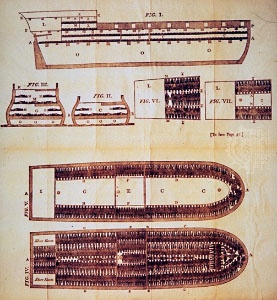Middle Passage
slave trade
 in the days of the African slave trade to the New World, the middle part of the slave's journey—i.e., the crossing of the Atlantic Ocean. From about 1518 to the mid-19th century, millions of African men, women, and children made the 21-to-90-day voyage aboard grossly overcrowded sailing ships manned by crews mostly from Great Britain, the Netherlands, Portugal, and France.
in the days of the African slave trade to the New World, the middle part of the slave's journey—i.e., the crossing of the Atlantic Ocean. From about 1518 to the mid-19th century, millions of African men, women, and children made the 21-to-90-day voyage aboard grossly overcrowded sailing ships manned by crews mostly from Great Britain, the Netherlands, Portugal, and France.Slaver captains anchored chiefly off the Guinea Coast for a month to a year to trade for their cargoes of 150 to 600 persons, most of whom had been kidnapped and forced to endure the march to the coast under wretched conditions. While at anchor and after the departure from Africa, those aboard ship were exposed to almost continuous dangers, including raids at port by hostile tribes, epidemics, attack by pirates or enemy ships, and bad weather. Although these events affected the ships' crews as well as the enslaved, they were more devastating to the latter group, who had also to cope with physical, sexual, and psychological abuse at the hands of their captors. Despite—or perhaps in part because of—the conditions aboard ship, some Africans who survived the initial horrors of captivity revolted; male slaves were kept constantly shackled to each other or to the deck to prevent mutiny, of which 55 detailed accounts were recorded between 1699 and 1845.
So that the largest possible cargo might be carried, the captives were wedged belowdecks, chained to low-lying platforms stacked in tiers, with an average individual space allotment that was 6 feet long, 16 inches wide, and perhaps 3 feet high (183 cm by 41 cm by 91 cm). Unable to stand erect or turn over, many slaves died in this position. If bad weather or equatorial calms prolonged the journey, the twice-daily ration of water plus either boiled rice, millet, cornmeal, or stewed yams was greatly reduced, resulting in near starvation and attendant illnesses.
In the daytime, weather permitting, slaves were brought on deck for exercise or for “dancing” (forced jumping up and down). At this time, some captains insisted that the sleeping quarters be scraped and swabbed by the crew; but in bad weather the oppressive heat and noxious fumes in the unventilated and unsanitary holds caused fevers and dysentery, with a high mortality rate. Deaths during the Middle Passage, caused by epidemics, suicide, “fixed melancholy,” or mutiny, have been estimated at 13 percent. So many bodies of dead or dying Africans were jettisoned into the ocean that sharks regularly followed the slave ships on their westward journey.
The Middle Passage supplied the New World with its major workforce and brought enormous profits to international slave traders. At the same time, it exacted a terrible price in physical and emotional anguish on the part of the uprooted Africans; it was distinguished by the callousness to human suffering it developed among the traders.
- Rampur
- Ramsay, Allan
- Ramsay, Bertram Home
- Ramsay MacDonald
- Ramsay, Sir William
- Ramsden, Jesse
- Ramses I
- Argeş River
- Argeș
- Arghezi, Tudor
- Arghūn
- arginine
- Argolis, Gulf of
- Argolís
- argon
- Argonaut
- Argonne
- Argonne National Laboratory
- Argos
- Arguedas, Alcides
- Arguedas, José María
- Arguello, Alexis
- Arguin Island
- argument
- argument from design